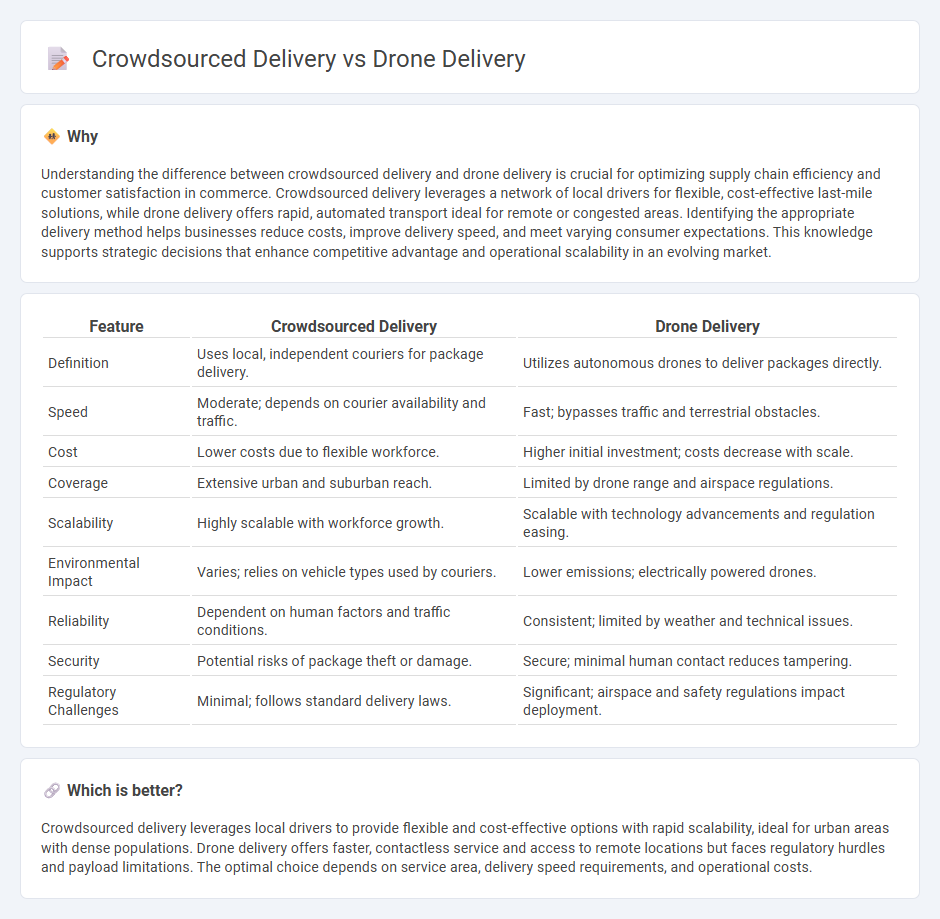
Crowdsourced delivery leverages local individuals to pick up and deliver goods, reducing last-mile costs and increasing flexibility in urban areas. Drone delivery utilizes autonomous aerial vehicles to transport parcels rapidly, enhancing speed and reaching remote locations where traditional delivery is challenging. Explore the distinct advantages and challenges of these innovative delivery methods to understand their impact on modern commerce.
Why it is important
Understanding the difference between crowdsourced delivery and drone delivery is crucial for optimizing supply chain efficiency and customer satisfaction in commerce. Crowdsourced delivery leverages a network of local drivers for flexible, cost-effective last-mile solutions, while drone delivery offers rapid, automated transport ideal for remote or congested areas. Identifying the appropriate delivery method helps businesses reduce costs, improve delivery speed, and meet varying consumer expectations. This knowledge supports strategic decisions that enhance competitive advantage and operational scalability in an evolving market.
Comparison Table
| Feature | Crowdsourced Delivery | Drone Delivery |
|---|---|---|
| Definition | Uses local, independent couriers for package delivery. | Utilizes autonomous drones to deliver packages directly. |
| Speed | Moderate; depends on courier availability and traffic. | Fast; bypasses traffic and terrestrial obstacles. |
| Cost | Lower costs due to flexible workforce. | Higher initial investment; costs decrease with scale. |
| Coverage | Extensive urban and suburban reach. | Limited by drone range and airspace regulations. |
| Scalability | Highly scalable with workforce growth. | Scalable with technology advancements and regulation easing. |
| Environmental Impact | Varies; relies on vehicle types used by couriers. | Lower emissions; electrically powered drones. |
| Reliability | Dependent on human factors and traffic conditions. | Consistent; limited by weather and technical issues. |
| Security | Potential risks of package theft or damage. | Secure; minimal human contact reduces tampering. |
| Regulatory Challenges | Minimal; follows standard delivery laws. | Significant; airspace and safety regulations impact deployment. |
Which is better?
Crowdsourced delivery leverages local drivers to provide flexible and cost-effective options with rapid scalability, ideal for urban areas with dense populations. Drone delivery offers faster, contactless service and access to remote locations but faces regulatory hurdles and payload limitations. The optimal choice depends on service area, delivery speed requirements, and operational costs.
Connection
Crowdsourced delivery and drone delivery are connected through their shared goal of enhancing last-mile logistics by leveraging innovative technology and decentralized resources. Both solutions optimize delivery speed and cost efficiency while reducing urban congestion and greenhouse gas emissions. Integration of drone technology into crowdsourced platforms can further streamline package distribution in hard-to-reach locations, amplifying delivery network scalability and sustainability in commerce.
Key Terms
Last-mile logistics
Drone delivery streamlines last-mile logistics by offering rapid, contactless transportation, reducing delivery times and bypassing urban traffic congestion through automated flight paths. Crowdsourced delivery leverages local couriers, enhancing flexibility and scalability by utilizing existing human resources for personalized and diverse delivery options. Explore the advantages and challenges of each approach to optimize your last-mile delivery strategy.
Fulfillment models
Drone delivery utilizes autonomous aerial vehicles to transport packages quickly, optimizing last-mile delivery with reduced human labor and traffic congestion. Crowdsourced delivery leverages a network of everyday commuters or gig workers to fulfill orders flexibly, scaling capacity based on demand and geographic coverage. Explore the benefits and challenges of each fulfillment model to determine the best fit for your logistics strategy.
Delivery scalability
Drone delivery offers rapid scalability through automated air routes, minimizing human labor and reducing delivery times significantly. Crowdsourced delivery relies on a flexible network of local couriers, allowing quick scalability based on demand but facing potential variability in service quality. Explore the advantages and limitations of these delivery models to determine which best suits your scalability needs.
Source and External Links
Delivery drone - Wikipedia - Delivery drones are unmanned aerial vehicles designed to transport packages, medicines, food, and other light goods, used by major companies and widely deployed in medical supply delivery worldwide for faster, obstacle-free service.
Amazon's drones deliver items in 60 minutes or less--here's how we ... - Amazon's advanced drone delivery system can deliver over 60,000 items within 60 minutes, using digital maps to select obstacle-free delivery points and new drones that can autonomously confirm package drop-off without physical markers.
A2Z Drone Delivery | Advanced Drone Delivery Technology - A2Z Drone Delivery provides commercial drone technology specialized for last-mile, emergency medical, industrial inter-site transport, and port deliveries, featuring scalable infrastructure and automated charging systems.
 dowidth.com
dowidth.com